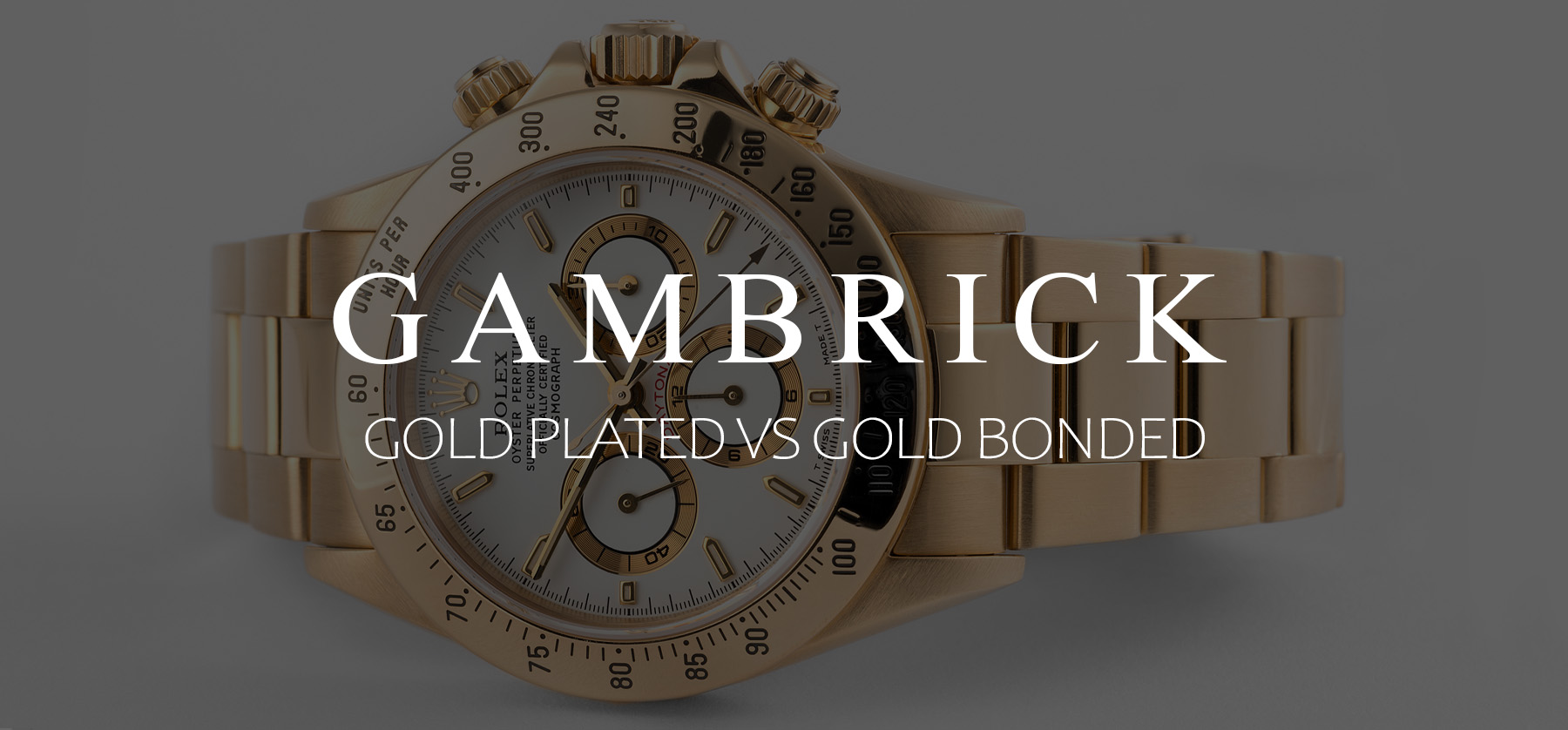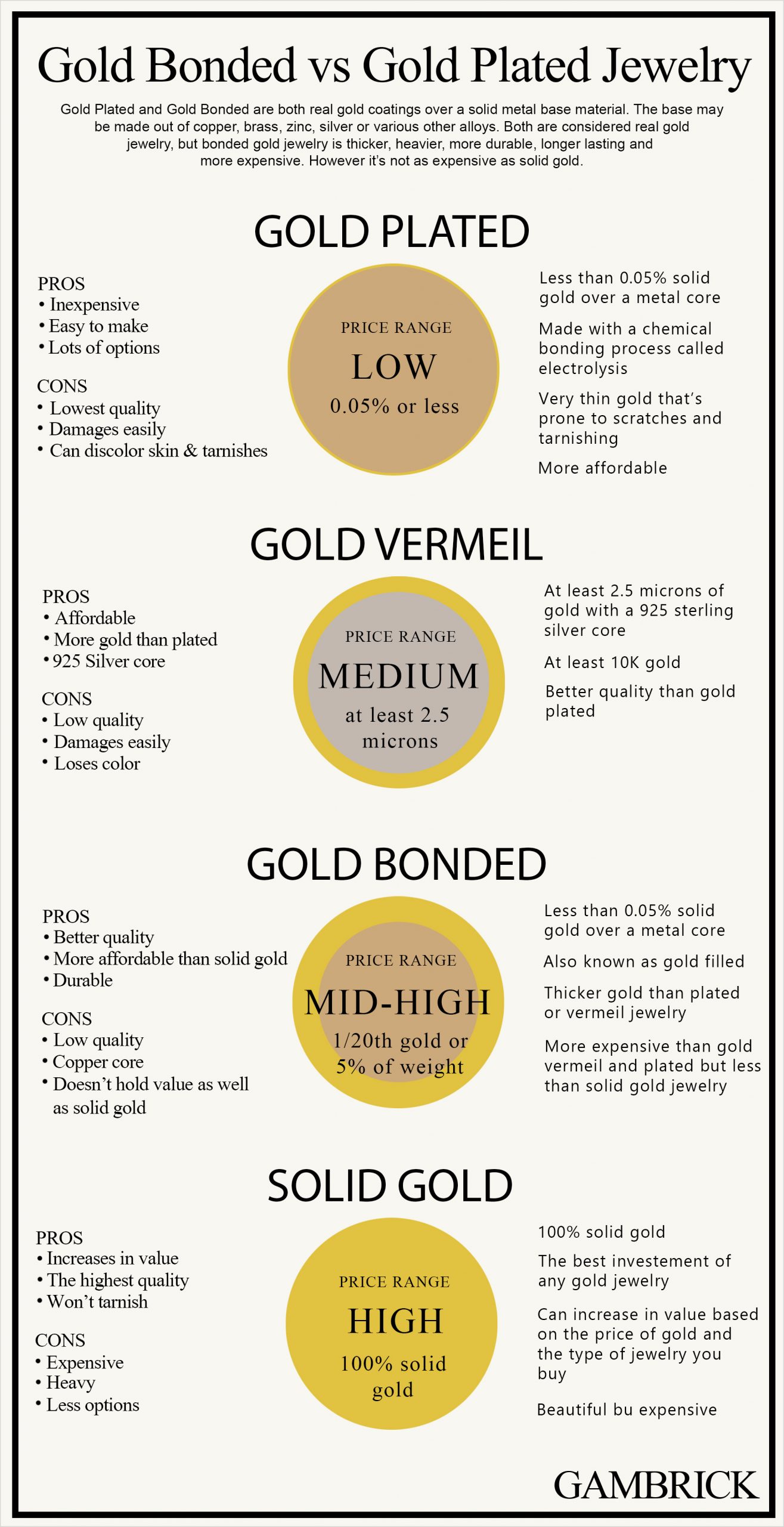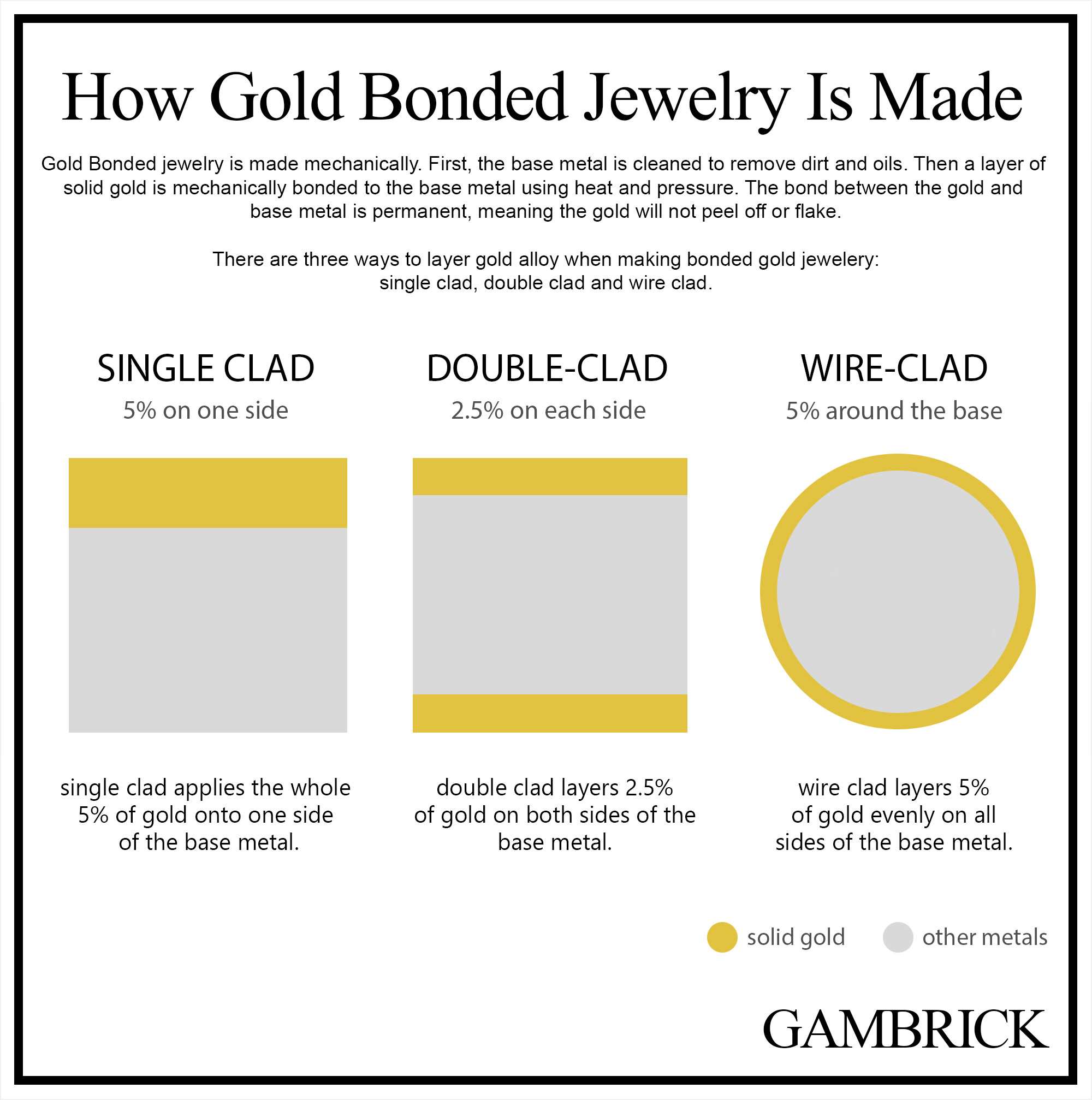

By John Mazzuca | About | More Posts |
John Mazzuca is a custom home builder with over 25 years experience in the construction industry. John has designed, managed, and built hundreds of homes & construction projects.
Gold Plated Vs Gold Bonded
When shopping for gold jewelry, you’ll often hear the terms gold plated vs gold bonded. Unless you’re buying a solid gold piece, the inside of the jewelry will be metal with gold on the outside. Gold plated and gold bonded refer to how the gold is applied to the metal and how thick it is. It’s important to understand the difference before you make a purchase because it affects the quality of the item and the price.
Gold plated is the most affordable type of gold jewelry. The gold is applied to the outside of the metal in a very thin layer, typically in the 0.25 – 0.5 micron range (0.00001”-0.00002”), which makes it easy to damage or rub off. Because of how inexpensive it is, many fashion brands use gold plating instead of gold bonding. But no matter how thin the gold layer is, it’s still real gold and isn’t cheap.
Gold bonded jewelry is similar to gold plated because neither is solid gold. However, gold bonded has much thicker layers of gold, which makes it heavier, more durable, better quality, longer lasting, and more expensive. Unlike gold plating which uses a variety of base alloys, gold bonded jewelry always uses 925-sterling silver or jewelers brass. This increases the jewelry’s quality and value even more.
Both gold plated and gold bonded jewelry is technically considered real gold. And it’s hard to tell the difference between solid gold, gold bonded, and gold plated simply by looking at it. But gold bonded is much higher quality, uses more gold, and can last a lifetime. Whereas the typical period of time gold plated jewelry lasts before tarnishing is around 2-5 years.

What Does Gold Plated Mean?
Gold plated is the most affordable type of gold jewelry. The gold is applied to the outside of the metal in a very thin layer, typically in the 0.25 – 0.5 micron range (0.00001”-0.00002”), which makes it easy to damage or rub off. Because of how inexpensive it is, many fashion brands use gold plating instead of gold bonding. But no matter how thin the gold layer is, it’s still real gold, which isn’t cheap.
Gold plating is done by electroplating a very thin layer of gold to a base metal of copper, nickel, brass, or another cheap alloy. How thick the plating is affects the quality, durability, and cost of the item plated.
A micron is 0.001 of a millimeter, so any gold plating that’s 1 micron or up is good quality gold. Anything less is cheaper fashion jewelry.
- Is gold plated jewelry considered real gold? Yes, although the gold coating is very thin, it’s still real gold.;
- Gold plated jewelry isn’t required to have a minimum percentage of gold to make it gold plated.
- A layer of real gold ranging from 10k to 14k is typically used as plating.
- Plating is usually done in the 0.25 – 0.5 micron range (0.00001”-0.00002”), look for a piece that’s at least 1 micron of real gold.
- Less than 1 micron of gold is considered fashion jewelry.
Gold plating is very thin and is plated to an inferior quality alloy that will eventually show through, making your plated piece less than 1% gold. If you’re shopping for plated jewelry, the thickness of the plating matters.
Gold plated jewelry should not get wet and may turn your skin green or black. If you have allergies or sensitive skin, but solid gold or gold bonded instead.
How Is Gold Plating Done?
Gold plating is a very common process used to make gold jewelry. If you visit a mall jewelry store or kiosk, most of what you see is gold plated. It’s impossible to identify the differences between solid gold, gold bonded, and gold plated jewelry just by looking at it because the gold used to make gold plated jewelry is real.
Gold plating is a fairly simple process.
- The surface of the base metal must be clean, if there’s any dust, dirt or oil present, gold may not adhere to the base alloy. Cleaning may involve stripping, polishing, sandblasting, tumbling, and a variety of liquid chemical cleaners. This improves the adherence of the base alloy and keeps the plating tank free of contaminants.
- A second deep cleaning is done to remove any oil or dirt
- The item is rinsed to remove any cleaning chemicals
- A base layer of copper or nickel is applied to the alloy.
- The base alloy is submerged into the plating solution hung from a cathode bar (a pole with a negative electrical charge).
- An electric charge is applied, which attracts the positively charged ions in the gold plating solution.
- The thickness of the plating is controlled by the time it’s in the tank.
- Once removed from the tank, the gold plated piece is rinsed and dried.
The alloys that can be used as base metal are, silver, copper, nickel, titanium, tungsten, brass, and stainless steel. However, the most common metal used to make gold plated jewelry is silver and copper.
What Does Gold Bonded Mean?
Gold bonded jewelry is similar to gold plated because neither is solid gold. However, the layer of gold is much thicker, which makes gold bonded items heavier, more durable, better quality and more expensive. Unlike gold plating which uses a variety of base alloys, gold bonded jewelry always uses 925-sterling silver or jewelers brass. This increases the items quality and value even more.
Next is the gold itself, the amount of gold must be above 5% to be considered gold bonded.This is much more than the typical 1% that you’ll find on gold plated jewelry. In the United States, the Federal Trade Commission requires a layer of gold at least 2.5 microns thick.
- Because the gold layer is quite thick, at least 2.5 microns, it maintains a beautiful shine and color.
- Gold bonded jewelry is durability enough to withstand sweat, water, and overall wear and tear.
- Gold bonded has more gold than gold plated.
- The base alloy is always 925-sterling silver or jewelers brass.
- Gold bonded chains won’t turn your neck green and shouldn’t irritate your skin because the outer gold shell is thick, even if you’re sensitive to jewelry.
- Gold bonded layers may include various karats such as, 10K, 14K, 18K, and, 24K.
The major difference between gold plated and gold bonded is how thick the outer layer of gold is.
If you want gold jewelry that lasts but is more affordable than solid gold, gold bonded is a good option. As long as you take care of gold bonded jewelry and keep it clean, it will last a long time.
How Is Gold Bonding Done?
Gold bonded jewelry is made by mechanically bonding a layer of gold to a 925-sterling silver or jewelers brass base. The gold is bonded to the surface of the base metal using heat and pressure. This is a permanent bond so the gold won’t flake, peel or rub off like gold plating can.
By law, the total weight of a gold bonded item must contain 5% (or 1/20) of gold. If it contains less than 5%, it cannot legally be called gold bonded. For comparison, the total amount of gold found in a typical gold plated item is usually under 0.05% of the overall weight.
There are three different ways to layer the gold alloy to create gold filled jewellery:
- Single clad: The entire 5% of gold is layered on one side of the base metal.
- Double clad: The 5% gold weight is layered on both sides of the base metal.
- Wire clad: The 5% gold is layered around the entire wire.
Gold bonded items are much higher quality and more expensive than gold plated, but they’re more affordable than solid gold. The process isn’t just used as an outer coating, it can also be riveted, stamped and worked lightly with a hammer.
Unlike gold plated, gold bonded jewelry can last a lifetime if cared for properly. They’re resistant to heat, cold and water and are tarnish-free under normal conditions.

Are Gold Plated & Gold Bonded The Same?
Gold plated and gold bonded are not the same. While they’re both a real gold coating over a base metal, the manufacturing process and gold quantity are different.
- Gold plating is done using electrolysis. The gold is applied to the outside of the base metal in a very thin layer, typically in the 0.25 – 0.5 micron range (0.00001”-0.00002”), which makes it easy to damage or rub off.
- Gold bonding is done by mechanically bonding a layer of gold to a 925-sterling silver or jewelers brass base. By law, the total weight of a gold bonded item must contain 5% (or 1/20) of gold. If it contains less than 5%, it cannot legally be called gold bonded. For comparison, the total amount of gold found in a typical gold plated item is usually under 0.05% of the total weight.
The gold layer on gold plated jewelry is extremely thin. It can turn green, stain your skin or cause an allergic reaction. In most cases, gold plated jewelry is considered fashion jewelry.
Gold bonded jewelry has a much thicker gold layer, in some cases 100x more, meaning it’s more durable, higher quality and expensive.
| Gold Plated | Gold Bonded |
| Created by applying a very thin gold sheet onto a base metal using chemicals and electrolysis | Created by permanently joining a base metal with outer layers of gold using heat and pressure |
| Contains much less gold | Contains more gold |
| Not very durable | Much more durable |
| Inexpensive | More expensive |
| Generally considered fashion jewelry | Can last a lifetime |
| May cause a skin reaction | Usually does not cause an allergic reaction |
Both gold plated and gold bonded jewelry are considered real gold. But gold bonded jewelry is more durable, better quality, longer lasting and more expensive because it has thicker gold.
Is Gold Bonding Better Quality Than Gold Plating?
Yes, bonded gold is much better than plated gold because the gold is much thicker. By law, the total weight of a gold bonded item must contain 5% (or 1/20) worth of gold. If it contains less than 5%, it can’t legally be called gold bonded. For comparison, the total amount of gold found in a typical gold plated item is under 0.05% of the total weight. This makes gold bonded items much more durable, long lasting, higher quality and expensive.
Most gold bonded jewelry is around 100 times thicker gold compared to gold plated jewelry. For this reason, gold bonded jewelry typically doesn’t cause skin reactions like gold plated jewelry can.
- Gold Plating is accomplished by attaching gold to a base metal using chemicals and electrolysis. Because of this method, the gold layer is thinner and not as permanent. The gold can chip, flake and rub off.
- Gold Bonding is applied to a base metal with pressure and heat. Typically, multiple layers of gold are applied to the base metal which creates a permanent bond that won’t chip, flake or rub off.
In gold bonded jewelry the gold sheets are bonded to the base metal through extreme pressure and heat, which prevents the jewelry from flaking or tarnishing.
Is Gold Bonded Jewelry Worth More Than Gold Plated?
Yes, gold bonded jewelry is worth more than gold plated. In most cases, gold plated is considered fashion jewelry. It’s real gold, but of a lower quality because the gold layer is very thin and in some cases rubs off and becomes tarnished. Gold bonded jewelry has a much thicker layer of gold, in some cases 100x thicker, which make it more durable, high quality, longer lasting and expensive.
- The price of gold bonded jewelry depends on how many karats are used to manufacture the jewelry and how much gold is used.
- Gold bonded jewelry contains 2 to 3 sheets of solid gold which may include 10K, 14K, 18, and 24K.
- By law, the total weight of a gold bonded item must contain 5% (or 1/20) worth of gold. If it contains less than 5%, it can’t legally be called gold bonded.
- For comparison, the total amount of gold found in a typical gold plated item is under 0.05% of the total weight.
Gold bonded jewelry can last a lifetime if properly cared for. The outer layer of gold is thick which makes it highly resistant to tarnish. And because the bonding process between the gold and base metal is permanent, the gold won’t chip, flake or rub off.
Gold bonded jewelry is considered real gold. It’s generally worth more than gold plated, but not as much as solid gold. But the actual value depends on the type of jewelry and the weight of the gold used.

How Long Does Gold Bonded Jewelry Last?
If you properly take care of gold bonded jewelry, it can last a lifetime. By law, the total weight of a gold bonded item must contain 5% (or 1/20) worth of gold. If it contains less than 5%, it can’t legally be called gold bonded. The gold used may include various karats such as, 10K, 14K, 18K, and, 24K and must be at least 2.5 microns thick. To be considered gold bonded jewelry, a lot of gold must be used to make it. Because of this, the pieces are of high quality, heavy, durable, resistant to tarnish and expensive.
Gold bonded jewelry is made by mechanically bonding layers of gold to a 925-sterling silver or jewelers brass base. The gold is bonded to the surface of the base metal using heat and pressure. This is a permanent bond so the gold won’t flake, peel or rub off like cheaper gold plating can.
You should clean your gold bonded jewelry with soapy water and dry it with a clean, soft cloth.
Are Bonded Gold & Plated Gold Real Gold?
Yes, bonded gold and plated gold jewelry are both considered real gold. However, they’re both a layer of gold on the outside over a metal base material rather than being made from solid gold. The base metal is typically copper, steel, silver, brass or zinc. It can be coated in anything from 10Kt to 24K real gold and in various thicknesses.
How Long Does Gold Plated Jewelry Last?
On average, gold plated jewelry lasts about 2 years. However, it can last 5 years or more if properly cared for. The longevity of gold plated jewelry depends on how often it’s worn, what type of elements touch it, how it’s stored and cared for, and how thick the plating is.
Gold plated is the most affordable type of gold jewelry. The gold is applied to the outside of a base metal in a very thin layer, typically in the 0.25 – 0.5 micron range (0.00001”-0.00002”). This makes it easy to damage or rub off. But thicker gold plating is much more durable, and lasts longer, than thin gold plating.
- Gold plated jewelry is affected by the elements.
- To make plated jewelry last longer, don’t wear it outside on rainy or humid days.
- Store your jewelry somewhere clean and dry.
- Avoid contact with chemicals like makeup, perfume, sunscreen, creams, moisturizers, soap and detergent.
- Never wear your jewelry to the beach or pool.
- Clean your jewelry with soapy water.
Just because a piece of jewelry is gold plated doesn’t mean it’s necessarily cheap or easily damaged. If the plating is thick, in some cases 1 micron and above, the piece can last a long time. Take care of your jewelry, avoid contact with harmful elements and store them properly and they’ll last for years without tarnishing.
Does Bonded Gold Wear Off?
Gold bonded jewelry is a base metal coated with a thick layer of gold using heat and pressure. The gold is thick and permanently bonded with the base metal, so it will not wear off over time, and if taken care of properly, it can last a lifetime.
By law, the total weight of a gold bonded item must contain 5% (or 1/20) worth of gold. If it contains less than 5%, it can’t legally be called gold bonded. The gold used may include various karats such as, 10K, 14K, 18K, and, 24K and must be at least 2.5 microns thick.
If you want the most durably gold bonded jewellery you can buy, select 10K.
Of the 4 most common gold purity levels used to make bonded gold jewelry, 10K is the most durable because it has the lowest gold content. 14K is slightly purer while also highly durable, while 24K gold is the purest and typically used for engagement rings and other jewelry, but it’s also the least durable.
Once you select your gold purity level, buy jewelry with the thickest gold coating you can afford. Thicker gold means it’ll be more durable and less likely to wear off or tarnish over time.
Summary: Gold Plated Vs Gold Bonded
When shopping for gold jewelry, you’ll often hear the terms gold plated vs gold bonded. Unless you’re buying a solid gold piece, the inside of the jewelry will be metal with gold on the outside. Gold plated and gold bonded refer to how the gold is applied to the metal and how thick it is. It’s important to understand the difference before you make a purchase because it effects the quality of the item and the price.
Gold plated is the most affordable type of gold jewelry. The gold is applied to the outside of the metal in a very thin layer, typically in the 0.25 – 0.5 micron range (0.00001”-0.00002”), which makes it easy to damage or rub off. Because of how inexpensive it is, many fashion brands use gold plating instead of gold bonding. But no matter how thin the gold layer is, it’s still real gold and isn’t cheap.
Gold bonded jewelry is similar to gold plated because neither is solid gold. However, gold bonded has much thicker layers of gold, which makes it heavier, more durable, better quality, longer lasting and more expensive. Unlike gold plating which uses a variety of base alloys, gold bonded jewelry always uses 925-sterling silver or jewelers brass. This increases the items quality and value even more.
Both gold plated and gold bonded jewelry is technically considered real gold. And it’s hard to tell the difference between solid gold, gold bonded and gold plated simply by looking at it. But gold bonded is much higher quality, uses more gold, and can last a lifetime. Whereas the typical period of time gold plated jewelry lasts before tarnishing is around 2-5 years.
If you have any questions or comments about gold plated vs gold bonded, email or leave a comment below.

John Mazzuca | About | More Posts |
Custom Home Builder
John Mazzuca is a custom home designer and builder at Gambrick with over 25 years experience in the construction industry. John has designed, built and/or remodeled hundreds of homes, small buildings, and commercial projects. He writes about business, real estate, home building, and household electronics. His work has been featured in Fox Business, Better Homes & Garden, House Beautiful, and more.




















